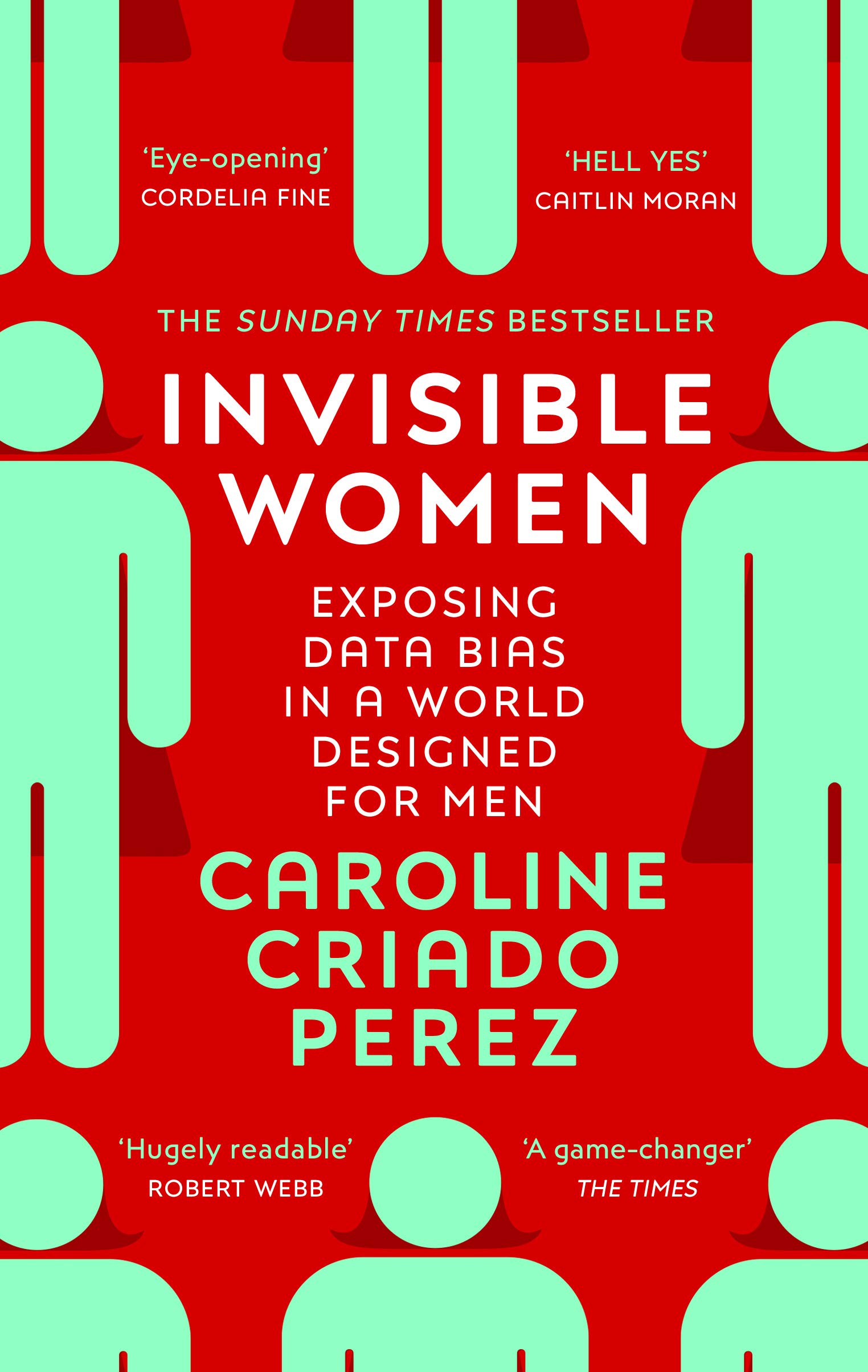
Author: Caroline Criado Perez
Genre: Non-fiction / Feminism / Data & Social Science
Ideal For: Readers who crave evidence-based storytelling. Anyone who has ever felt that the world was not designed with them in mind — and wants to understand, statistically and structurally, why. If you appreciate books that make invisible systems visible, Invisible Women is essential.
The Premise: The World Was Never Neutral
Invisible Women begins with a startling, simple premise: almost everything in the modern world — from smartphones to seatbelts, drug dosages to city planning — was designed around the assumption of a “default male.” Caroline Criado Perez calls it the “gender data gap”: the chronic failure to collect and apply data that accurately represents half the population.
Through hundreds of examples, she reveals how this oversight isn’t just an academic issue but a matter of life, death, and daily frustration. Car crash dummies are modelled on the average male body, meaning women are 47% more likely to be seriously injured in the same collision. Medical research, built on male physiology, results in women being misdiagnosed or given incorrect drug dosages. Even public infrastructure — from snow-clearing routes to bathroom queues — assumes men as the norm.
Perez doesn’t argue that men are maliciously designing systems to exclude women. She shows something subtler and more insidious: how the absence of women’s data leads to their invisibility, and how invisibility becomes inequality. The result is a book that fuses anger with clarity, outrage with proof.
Perez’s Voice: Fierce, Funny, and Forensic
Perez writes with energy, precision, and controlled fury. Her tone is unapologetically direct but also wickedly witty; you’ll find yourself laughing at the absurdity of what she reveals — and then realising the implications are deadly serious.
What makes her writing so effective is its rhythm: dense data delivered with storytelling instincts. Each chapter reads like a case study and a manifesto rolled into one. She’ll start with a vivid scene — a woman shoveling snow, a mother balancing care work, a doctor dismissing female pain — and then unfold the statistics that explain how systemic bias built those moments into the world.
Perez also avoids the trap of abstraction. Her language is human, grounded, and often biting: “When we say that data is neutral,” she writes, “what we really mean is that we’re not counting women.” It’s the kind of line that lodges itself in your mind like a new rule for reality.
Ten Words That Could Summarise This Book
Data. Design. Health. Safety. Work. Home. Money. Cities. Tech. Power.
Each chapter deals with one or several of these spheres, showing how bias multiplies through everyday systems. Together they form a lattice of invisibility — a map of how modern life privileges one body type, one schedule, one assumption.
Themes That Resonate
1. The Data Gap as Design Flaw.
Perez reveals that most data systems simply didn’t think to collect female-specific information. Whether in smartphone ergonomics (too large for smaller hands) or workplace air-conditioning (set to male metabolic rates), the gap isn’t just oversight — it’s infrastructure.
2. Medicine’s Gender Blindness.
From heart attack symptoms that differ by sex to drugs withdrawn for causing dangerous side effects in women, Perez exposes how medicine’s “neutral subject” is anything but. Her point is chilling: women are dying not because biology is mysterious, but because research ignores them.
3. The Economy of Care.
Women perform the majority of unpaid labour — childcare, eldercare, emotional care — yet economic models rarely account for it. Perez argues that this omission is both statistical and moral: a society that doesn’t count women’s work can’t value it.
4. Cities Built for Others.
Urban planning is revealed as an arena of bias. Streets unsafe for women at night, transport routes that ignore multi-stop commutes, underlit areas designed without gender safety in mind — these aren’t “bad luck.” They’re bad data.
5. The Myth of Meritocracy.
Perez dismantles the belief that women “choose” lower pay or fewer leadership roles. When structures are built around male patterns of behaviour — from meeting times to parental leave — the playing field is not level; it’s tilted by design.
6. Technology’s Old Problem in New Form.
Voice recognition software that misreads female voices, AI that reproduces sexist hiring patterns — Perez shows that bias isn’t vanishing with progress; it’s being automated. Her warning is quiet but dire: “The future will be coded by those who are counted.”
What Works Brilliantly
The balance of outrage and reason. Perez writes with urgency but never loses control. The facts speak, but she frames them with wit and warmth.
Clarity of structure. The book moves smoothly from public spaces to private bodies, connecting the dots between policy and daily life.
Intersectional awareness. While gender is central, she acknowledges race, class, and geography, showing that invisibility is layered.
Accessible without simplification. You don’t need to be a data analyst to grasp the stakes — yet the rigour is unmistakable.
Memorable storytelling. Every statistic has a face, every face has context. You’ll remember the snow-clearing policy of a Swedish town that flipped its priorities and reduced injuries overnight — because it counted women’s commuting patterns.
A Small Quibble (But a Necessary One)
If you’re looking for narrative comfort, you won’t find it here. Perez doesn’t soothe; she provokes. Some may feel overwhelmed by the scale of the problem or wish for more step-by-step solutions. But perhaps that’s deliberate. The book’s goal isn’t to close the issue neatly — it’s to keep your eyes open.
Why Invisible Women Matters — and Still Feels Radical
What makes Invisible Women extraordinary is its universality. It’s about the world’s half that’s missing from the record — but once you read it, you see how this omission touches everyone.
You’ll never look at a public bathroom queue without thinking of the architectural bias that built it. You’ll feel the seatbelt cutting across your chest differently, knowing it was never tested for your anatomy. You’ll notice how “gender-neutral” workplaces often rely on invisible female labour.
And you’ll start asking the question Perez poses, implicitly, on every page: Who was this made for?
That question alone can change industries. It’s already changed how readers approach design, tech, medicine, and policymaking. Perez doesn’t just reveal inequality — she gives us the lens to detect it everywhere.
The Emotional Undertone
Beneath the statistics runs something deeply human: frustration, but also fierce hope. Perez loves data because she loves evidence — and evidence can change the world. The anger in her voice is constructive, rooted in the belief that when we know better, we can do better.
Her humour, too, is a quiet act of resistance. When she describes women in snow boots navigating poorly ploughed sidewalks, she’s pointing to more than inconvenience; she’s describing a world that refuses to see what doesn’t fit its mold. Yet she writes with such precision that outrage becomes illumination.
The Takeaway: Seeing the Invisible
Reading Invisible Women feels like acquiring a new sense. Suddenly, you see bias embedded in objects, systems, and habits you never questioned. The book trains your vision — not to despair, but to demand.
Perez’s argument isn’t anti-male; it’s pro-data. It’s a call to treat women’s experiences not as “special interest” but as human baseline. Equality, she suggests, isn’t about favour; it’s about accuracy.
Why It Deserves Five Stars
Because it redefines what a “feminist book” can be. This isn’t rhetoric or ideology; it’s architecture, medicine, technology, governance — all made visible through the simplest of tools: numbers. Perez’s achievement is turning invisible injustice into measurable reality, and measurable reality into moral urgency.
Few books manage to shift both personal perspective and institutional conversation. Invisible Women does both. It’s exhaustively researched, sharply written, and completely unignorable.
Invisible Women earns every one of its five stars because it’s more than a book — it’s an x-ray of the modern world. Caroline Criado Perez turns data into empathy and outrage into clarity. You close the book not just informed, but altered.
If you’ve ever felt unseen by design, this is your proof — and your rallying cry.


